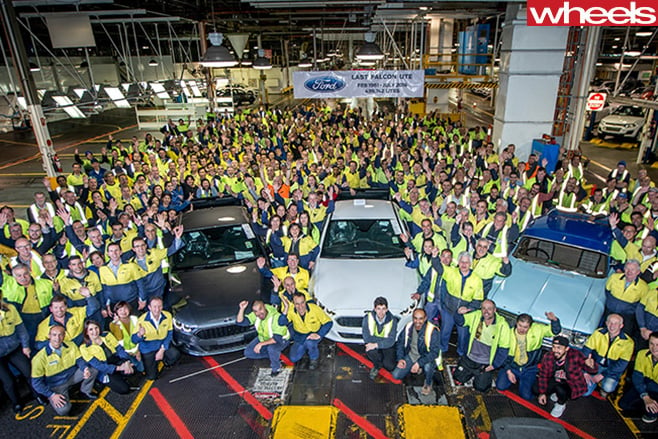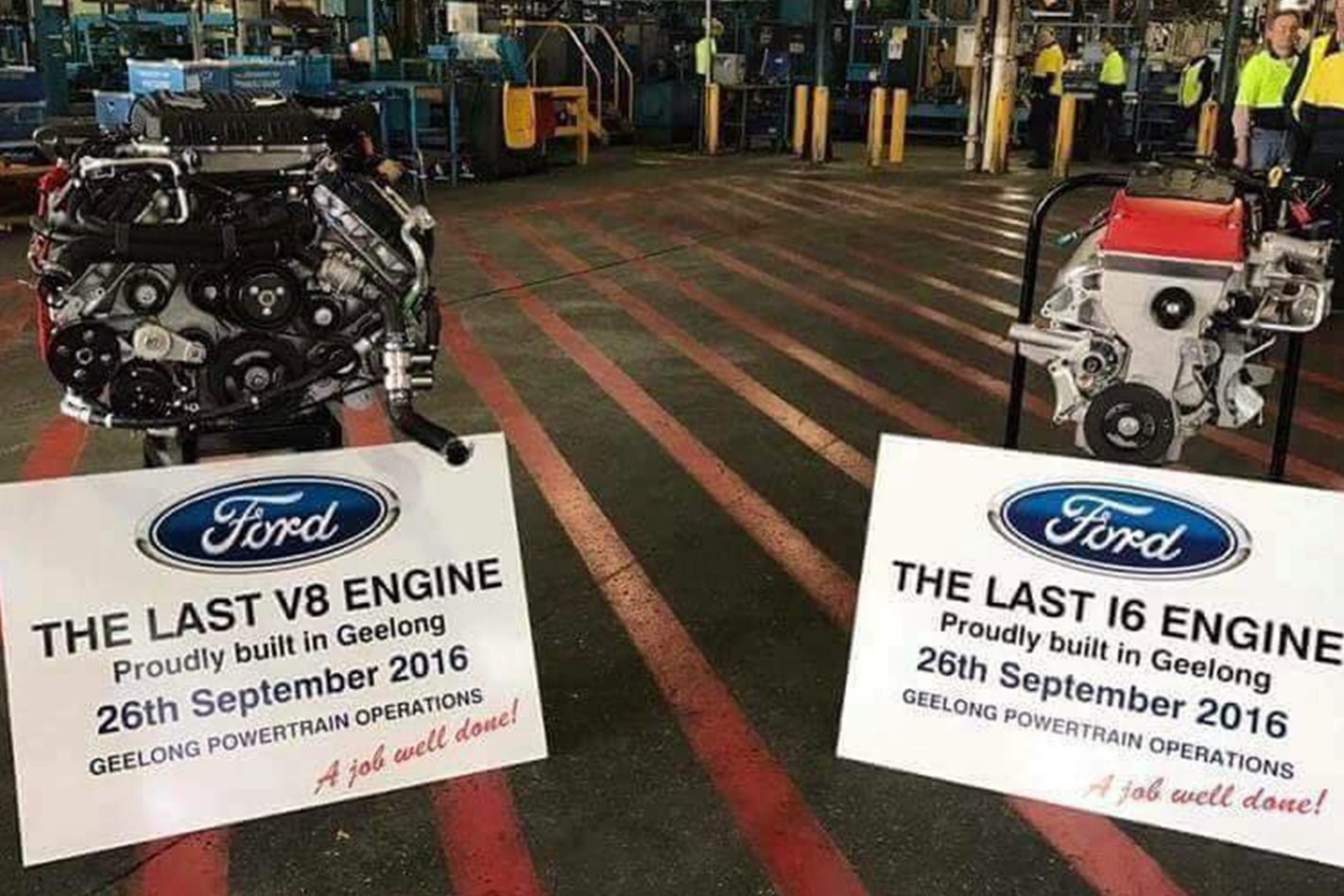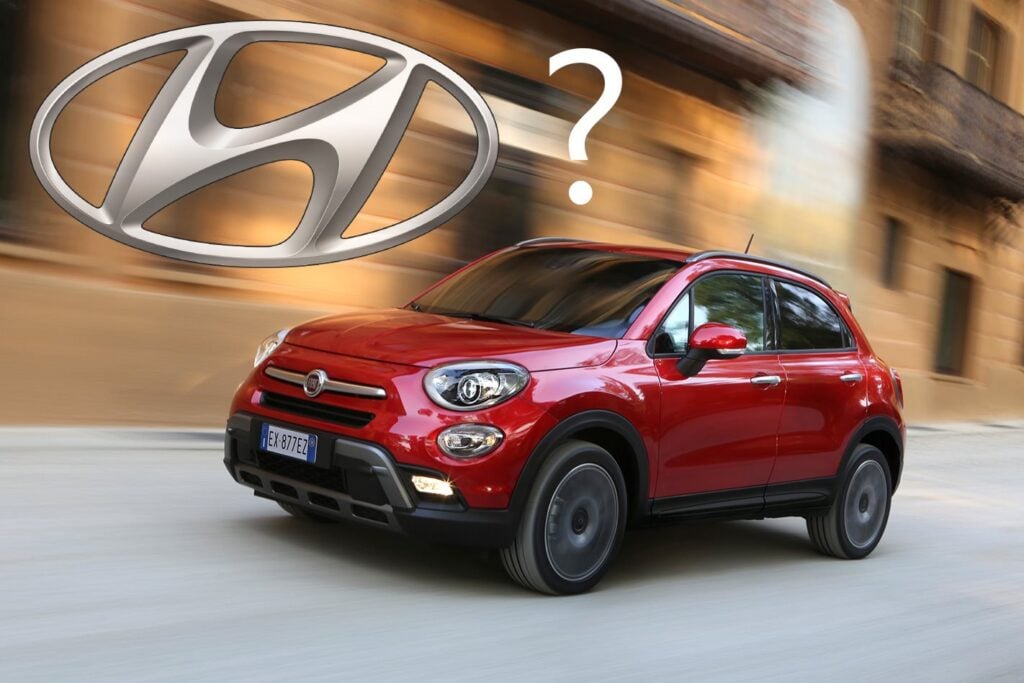TODAY hurts. Ford has officially signed off the last two engines to come off its Geelong production line, turning off the key on more than 90 years of history that has passed through the site.
The engines, an imported 5.0-litre V8 that’s modified here and fitted with a Harrop supercharger, and a 4.0-litre in-line six-cylinder – the most Aussie engine the carmaker builds – were commemorated in a line-off ceremony at the Geelong Powertrain Operations today.

A single image posted to Twitter shows the two engines mounted on the end of the Geelong assembly line, bearing a placard reading “Proudly built in Geelong 26 September 2016 Geelong Powertrain Operations”. Both engines are signed off with “A job well done!”
Ford Australia said the last engines were part of a staged shutdown of its Australian carmaking operations, which included the last Falcon ute rolling off its Broadmeadows production line on July 29.
“We’re obviously working towards the end of production and to support that there will be different milestones that happen along the way including the end of engine production. But all our employees will be with us until October 7, that’s when we’ll pay tribute to them on that day.”
Sherwood wouldn’t be drawn on Ford’s intentions for the engines, refusing to say whether they’re destined for use in the last Falcons to roll down the production line, or to be preserved as museum pieces.
“I’m not going to comment on that, our focus is on October and the end of local manufacturing on October 7. As I said there will be milestones along the way, and there have been already, but we really want to pay tribute to our employees and our manufacturing history on October 7.”

In November 1982, Ford announced it would halt V8 production, saying it would be replaced with an electronic fuel injection version of the in-line six. According to Ford, the EFI engine “offered virtually the same performance as the 4.9-litre V8 but with substantial savings in fuel consumption”. It was to prove a big mistake, handing rival carmaker Holden a big marketing advantage.
FALCON ENGINES THROUGH TIME 1960: 144 cubic inch, 6cyl, ohv 1962: Pursuit 170c.i. introduced 1964: 200 Super Pursuit engine introduced 1966: 289c.i. V8 introduced as an option; 144c.i. deleted 1968: 302c.i. 4.9-litre V8 introduced; 289c.i. V8 deleted; 3.1/3.6-litre sixes introduced 1969: 351c.i. 5.8-litre V8 introduced 1970: 200/250c.i. 3.3/4.1-litre sixes introduced 1976: Crossflow heads introduced on sixes 1980: Alloy head introduced 1982: Alloy head II introduced; V8 deleted 1984: Electronic engine control IV introduced 1988: Inline sixes re-engineered for ohc 1991: 5.0-litre V8 returns 1992: 4.0-litre six introduced; XR6 joins range with Tickford-modified 4.0-litre in-line six 1994: 4.0-in-line six uprated to 157kW 1999: Ford Tickford Experience-tuned sixes, Windsor V8 2000: Engine service intervals increased from 10,000km to 15,000km 2001: Windsor 5.0-litre V8 deleted 2002: Turbo 4.0-litre in-line six introduced; “Boss 260” 5.4-litre dohc V8 introduced 2004: FPV F6 Typhoon features 270kW turbo in-line six 2005: Major changes to the in-line six for BF Falcon 2006: Six-cyl engine’s thermal management overhauled for faster warm-up and better fuel use 2008: XR6 Turbo gains more torque; 310kW turbo in-line six FPV F6 introduced 2010: XR8 discontinued due to emissions controls; FPV introduces 315kW Miami supercharged 5.0-litre V8 2014: 2.0-litre four-cyl introduced for Falcon; 5.0-litre V8 returns; XR6 Sprint gains 325kW turbo six





